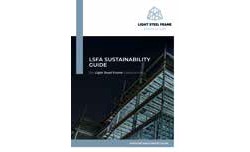The offsite industry can play a vital role in achieving a circular economy by reducing the large-scale use of raw materials. Mike Fairey, Chair of the Light Steel Frame Association (LSFA) explains how the light gauge steel sector is driving change.
At its simplest, the circular economy prioritises the reuse of materials, preventing the over extraction of natural resources and the amount of usable construction components that end up in landfill. There is growing pressure on the construction industry to reduce waste and to achieve this we have to move towards resource efficiency.
But first we have to address the commercial realities associated with making this practically happen by ensuring information is readily available. Steel has excellent circular economy credentials both as a material which is strong and durable and as a structural framing system which is lightweight, adaptable and reusable. The qualities of strength, longevity, recyclability, availability, versatility and affordability make light steel frame unique.
Circular Construction Principles
Design optimisation is crucial in a circular construction approach and a lot of thinking has to be done up front. Once the architectural priority was form and function but now there are a raft of considerations coming to the fore such as design for longevity, flexibility, adaptability and the offsite mantra of – design for manufacture and assembly (DfMA). But that is not all, it is imperative to plan for a building's 'end' right at the beginning of the design stage to enhance the sustainability value chain through design for disassembly and recoverability protocols.
Manufactured from the most abundant component on earth, steel can be recycled or reused endlessly without detriment to its properties. This unique characteristic gives steel a high value at all stages of its lifecycle. The recovery infrastructure for steel recycling is highly developed and extremely efficient and has been in place for decades. Current recovery rates from demolition sites in the UK are 99% for structural steelwork and 96% for all steel construction products – figures that far exceed those for any other construction material.
Research carried out by the LSFA's technical partner, the Steel Construction Institute (SCI) has estimated that there are around 100 million tonnes of steel in buildings and infrastructure in the UK. This 'stock' of steel is an important and valuable material asset that means we are largely self-sufficient in steel and can virtually produce all the steel we need through recycling or reusing our latent stock to satisfy market demand. The LSFA is on a mission to champion steel's sustainability benefits and its role in the circular economy. Many of our members use light steel framing systems which contain over 50% of recycled stock.
Recycling is often seen as the ultimate goal although reuse for its original or similar purpose without vastly altering the physical form, is equally if not more important but it rarely gets a mention. But how many construction components can be reused with little or virtually no reprocessing? I can only think of one. Reuse offers even greater environmental advantages than recycling since there is no, or few environmental impacts associated in reprocessing.
Material Efficiency
Light steel frame is often used for complex buildings where additional structural integrity is necessary and provides the answer to complex questions where a lightweight response is required. Low weight equates to improved efficiencies – you get a lot of structure for relatively little weight which reduces embodied carbon. This is where steel cannot be beaten. Lighter structures not only reduce material consumption but also concrete in the ground with foundation loads and sizes reduced by over 70% relative to block-work construction.
According to research carried out by independent consultants Construction Markets – steel continues to be overwhelmingly the structural framing material of choice with their survey showing that steel now has a 72.5% share of the multi-storey office market and a 60.9% share in the 'other multi-storey buildings' which includes retail, education, leisure and healthcare sectors. The UK leads the world in steel construction commercially, technically and in terms of quality, and the light steel frame industry is playing a huge part in the dramatic improvements it has made in technology, productivity and efficiency.
SUSTAINABILITY GUIDE
With an objective to support specification through developing a better understanding of the benefits, the LSFA has launched an informative Sustainability Guide to verify the environmental credentials of light steel framing technology. Areas covered in the guide include sustainability in light steel frame construction, key environmental benefits and ways of reducing embodied carbon now and in the future. There are also references for further reading which covers the subject of sustainability in more detail.
For more information and to download the Sustainability Guide visit: www.lsf-association.co.uk









